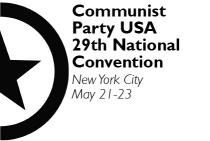 This article is part of the discussion leading up to the Communist Party USA’s 29th National Convention May 21-23, 2010. CPUSA.org takes no responsibility for the opinions expressed in this article or other articles in the pre-convention discussion. All contributions must meet the guidelines for discussion. To read other contributions to this discussion, visit the site of the Pre-Convention Discussion period.
This article is part of the discussion leading up to the Communist Party USA’s 29th National Convention May 21-23, 2010. CPUSA.org takes no responsibility for the opinions expressed in this article or other articles in the pre-convention discussion. All contributions must meet the guidelines for discussion. To read other contributions to this discussion, visit the site of the Pre-Convention Discussion period.
All contributions to the discussion should be sent to discussion2010@cpusa.org for selection not to the individual venues.For more information on the convention or the pre-convention discussion period, you can email convention2010@cpusa.org.
In this whole piece, “Moving toward a leadership criteria”, there is no clear reference to our basis of thought and action as communists: class struggle and our relationship(s) with workers, and therefore with ourselves.
Every worker is important because each is a potential recruiter for more workers, or a “crowd” of workers conditioned by a vast and awful set of historical production relations of class struggle. The CPUSA has a long established Constitutional and political policy of developing individuals and worker “crowds” within the club structure. Unfortunately, this structure has disappeared in the MO/KAN district of the CPUSA. Because of this, the whole basis and Party Constitutionality of our operation may be in question.
From our Communist Manifesto: “Modern industry has established the world market, for which the discovery of America paved the way.”
We are Americans. We may consider ourselves St. Louisans, we may consider ourselves New Yorkers, but we are Americans. What has conditioned the world market in general-modern industry, has conditioned us in particular. What has blurred differences of workers worldwide, has blurred differences between workers in St. Louis; we are unified by modern industry and our relationship to it, and if we recognize this and consciously unite with our class brothers and sisters we become an great power, so awesome that we can challenge the existing order in a basic way. We can challenge so successfully that we can transfer the political power to ourselves, locally, nationally and internationally, based on our connection to Karl Marx’s world market. Again, from our Communist Manifesto:
“The proletariat (not the communists — E.E.W.) will use its political supremacy to wrest, by degree, all capital from the bourgeoisie, to centralize all instruments of production in the hands of the state, i.e. of the proletariat organized as the ruling class; and to increase the total productive forces as rapidly as possible.”
In the paragraph after next, Marx and Engels go on to state, that this “proletariat organized as the ruling class” will call for certain measures.
“These measures will, of course, be different in different countries.”
W.E.B. Du Bois has supplied us with “certain measures”- one to whom Gus Hall has written: “Your life is a monumental example for achievement for all Americans.” This American summary of Communist measures, which is very accurate – albeit nearly 50 years old – and very materially similar to the ten measures under Section II. Proletarians and Communists in the Communist Manifesto of Karl Marx and Friedrich Engels, of 1848 – they are important enough to list:
- Public ownership of natural resources and of all capital.
- Public control of transportation and communications.
- Abolition of poverty and the limitation of personal income.
- No exploitation of labor.
- Social medicine, with hospitalization and care of the old.
- Free education for all.
- Training for jobs and jobs for all.
- Discipline for growth and reform.
- Freedom under law.
- No dogmatic religion.
These measures need to be sought by communists in our local, state, regional and national divisions by workers as individuals and especially in groups.
The club is the ideal formation in which these goals can be worked on.
How can districts, the national body, or the international working class for that matter, solve the problems of workers outside of this essential base of the clubs?


 Join Now
Join Now